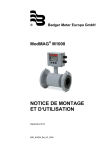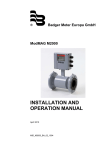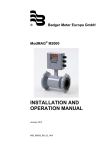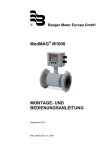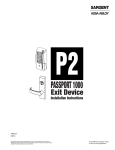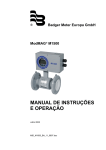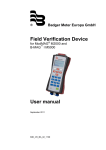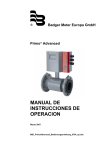Download ModMAG M1000 INSTALLATION AND OPERATION MANUAL
Transcript
® Badger Meter Europa GmbH ModMAG® M1000 INSTALLATION AND OPERATION MANUAL August 2014 MID_M1000_BA_02_1408 Contents Page 1. Basic safety precautions .................................................................................................. 1 2. System description............................................................................................................ 2 3. Installation .......................................................................................................................... 4 3.1 General information ................................................................................................... 4 3.1.1 Temperature ranges ....................................................................................... 4 3.1.2 Protection class .............................................................................................. 4 3.1.3 Transport ........................................................................................................ 5 3.2 Installation .................................................................................................................. 5 3.2.1 Meter orientation ............................................................................................. 5 3.2.2 Inlet and outlet pipe ........................................................................................ 5 3.2.3 Meter location ................................................................................................. 6 3.2.4 Pipe reducer requirements ............................................................................. 7 3.2.5 Separate version ............................................................................................. 8 3.2.6 Grounding and potential equalization ............................................................. 8 3.2.7 Plastic or lined pipelines ................................................................................. 9 3.2.8 Pipelines with cathodic protection ................................................................... 9 3.2.9 Electrically disturbed environment ................................................................ 10 4. Power connections .......................................................................................................... 11 4.1 Auxiliary power......................................................................................................... 11 4.2 Separate version ...................................................................................................... 12 4.2.1 Signal cable specification ............................................................................. 13 4.3 Configuring input/output (I/O)................................................................................... 14 4.3.1 In- and output cable connection .................................................................... 15 5. Programming ................................................................................................................... 16 5.1 Main menu ............................................................................................................... 17 5.1.1 Meter setup ..................................................................................................... 17 5.1.2 Measurement ................................................................................................ 19 5.1.3 Input and outputs ........................................................................................... 22 5.1.4 Clear totals .................................................................................................... 27 5.1.5 Communications ............................................................................................ 27 5.1.6 Miscellaneous ................................................................................................ 29 5.1.7 Info ................................................................................................................ 30 5.1.8 Pin ................................................................................................................. 31 5.1.9 Login .............................................................................................................. 31 6. Troubleshooting .............................................................................................................. 32 6.1 Control LED .................................................................................................................. 34 6.2 Replace meter’s electronics ..................................................................................... 35 7. Technical data .................................................................................................................. 36 7.1 Detector Type II ....................................................................................................... 36 7.2 Detector type Food .................................................................................................. 38 7.3 Detector Type III ...................................................................................................... 40 7.4 Meter type ModMAG® M1000 .................................................................................. 41 7.5 Error limits ................................................................................................................ 42 7.6 Size select................................................................................................................ 43 8. Program structure ........................................................................................................... 44 9. Return of goods for repair .............................................................................................. 46 Basic safety precautions Page 1/46 1. Basic safety precautions Before installing or using this product, please read this instruction manual thoroughly. Only qualified personnel should install and/or repair this product. If a fault appears, contact your distributor. Installation Do not place any unit on an unstable surface that may allow it to fall. Never place the units above a radiator or heating unit. Route all cabling away from potential hazards. Isolate from the mains before removing any covers. Power connection Use only the type of power source suitable for electronic equipment. If in doubt, contact your distributor. Ensure that any power cables are of a sufficiently high current rating. All units must be earthed to eliminate risk of electric shock. Failure to properly earth a unit may cause damage to that unit or data stored within it. Protection class The device has protection class IP 67 and needs to be protected against dripping water, water, oils, etc. Setup & operation Adjust only those controls that are covered by the operating instructions. Improper adjustment of other controls may result in damage, incorrect operation or loss of data. Cleaning Switch off all units and isolate from mains before cleaning. Clean using a damp cloth. Do not use liquid or aerosol cleaners. Repair of faults Disconnect all units from power supply and have it repaired by a qualified service person if any of the following occurs: If any power cord or plug is damaged or frayed If a unit does not operate normally when operating instructions are followed If a unit exposed to rain/water or if any liquid has been spilled into it If a unit has been dropped or damaged If a unit shows a change in performance, indicating a need for service. Failure to adhere to these safety instructions may result in damage to the product or serious bodily injury. Remove device from the pipeline If the device has been operated with toxic, caustic, flammable or water-endangering products you are kindly requested to check and ensure, if necessary by rinsing or neutralizing, that all cavities are free from such dangerous substances before you remove the device. Please read carefully chapter 9 “Return of goods for repair” and fill out the harmlessness declaration before you send back the device for repair. RoHs Our products are RoHs compliant. MID_M1000_BA_02_1509 System description Page 2/46 2. System description The electromagnetic flow meters are intended for the metering of all fluids with electric conductivity of at least 5 S/cm (20 S/cm for demineralized water). These series of meters is characterized by a high degree of accuracy. Measuring results are independent of density, temperature and pressure. Measuring principle In accordance with Faraday’s induction principle, electric voltage is induced in a conductor moving through a magnetic field. In case of the electromagnetic flow measurement, the moving conductor is replaced by the flowing fluid. Two opposite measuring electrodes conduct the induced voltage which is proportional to flow velocity to the amplifier. Flow volume is calculated based on pipe diameter. Measuring device The measuring device consists of the detector and an amplifier. The detector is installed in the pipeline and is available in different sizes, pressure rates, process connections and materials. The amplifier is directly mounted on the detector or available as a remote version. The amplifier display and totalizes the flow with different in- and outputs. See also chapter 7 for more details. Amplifier ModMAG® Detector MID_M1000_BA_02_1509 Installation Page 3/46 Nameplate Look at the device nameplate to ensure that the device is delivered according to your order. Check for the correct supply voltage printed on the nameplate. MID_M1000_BA_02_1509 Installation Page 4/46 3. Installation Warning: Installation instructions given in the following are to be observed in order to guarantee a perfect functioning and a safe operation of the meter. 3.1 General information 3.1.1 Caution: Temperature ranges In order to prevent a damaging of the meter, you are requested to strictly observe amplifier’s and detector’s maximum temperature ranges. In regions with extremely high ambient temperatures, it is recommended to protect the detector. In cases where fluid temperature exceeds 100 °C, foresee separate amplifier and detector (separate version). Amplifier Ambient temp. Detector Fluid temp. 3.1.2 -20 °C to + 60 °C PTFE / PFA -40 °C to +150 °C Hard rubber 0 °C to +80 °C Soft rubber 0 °C to +80 °C Protection class In order to fulfill requirements in respect of the protection class, please follow the following guidelines: Caution: Body seals need to be undamaged and in proper condition. All of the body screws need to be firmly screwed. Outer diameters of the used wiring cables must correspond to cable inlets (for M20 Ø 5 mm to 13 mm). In cases where cable inlet is not used, put on a dummy plug. Tighten cable inlets. If possible, lead cable away downwards. Thus humidity cannot get into cable inlet. We normally deliver the meter in accordance with protection class IP 67. If you however require a higher protection class, the amplifier is to be installed separately from the detector. If requested, we can also deliver the detector in IP 68. MID_M1000_BA_02_1509 Installation 3.1.3 Page 5/46 Transport Caution: Use lifting lugs when lifting meter flow tubes that are 150 in diameter or larger. Do not lift meter on measuring amplifier or on detector’s neck. Do not lift meter with a fork lift on the jacket sheet. This could damage the body. Never place rigging chains, forklift forks, etc inside or through the meter’s flow pipe for hoisting the meter. This could damage the isolating liner. 3.2 Installation In order to provide a perfect functioning and to prevent the meter from eventual damages, please follow the following installation instructions. Caution: Carefully observe the forward flow label on the meter body and install the meter accordingly. As for detectors with PTFE liner, remove protective cap on the flange or on the threaded pipes of milk pipe screws as per DIN 11851 not until shortly before installation. 3.2.1 Meter orientation Meters can operate accurately in any pipeline orientation. Meters can be installed in horizontal as well as in vertical pipelines. Meters perform best when placed vertically with liquid flowing upward as it prevents solids build-up. When installing the meter on a horizontal pipe, mount the meter to the pipe with the flow-measuring electrode axis in a horizontal plane as it prevents that gas bubbles result in a temporary isolation of the flow-measuring electrodes. Carefully observe the forward flow label on the meter body and install the meter accordingly. 3.2.2 Inlet and outlet pipe Always install the detectors in front of fittings producing turbulences. If this is simply not possible, foresee distances of > 3 x DN. Distance ought to be > 2 x DN. > 2 x DN M1000-18 > 3-5 x DN MID_M1000_BA_02_1509 Installation 3.2.3 Page 6/46 Meter location Do not install the detector on the suction sides of pumps. This could damage the liner (in particular PTFE liners). Verify that the pipeline is always filled on the measuring point, if not - a correct or accurate measurement is not possible. Do not install the detector on the highest point of a pipeline system. Gas accumulation may follow. Do not install the detector in downcomer pipes with free outlet. Do not install the detector on pipes with vibrations. If pipes are strongly vibrating, make sure that detector and amplifier are separated (separate version). >2 N xD MID_M1000_BA_02_1509 M1000-17 DN M1000-14 x -5 >3 M1000-16 M1000-15 h > 2 x DN Caution: Installation 3.2.4 Page 7/46 Pipe reducer requirements With pipe reducers as per DIN 28545 detectors can be mounted in larger pipelines. You can determine the occurring pressure drop by using the shown nomogram (only applicable to liquids with similar viscosity like water). In cases where flow velocities are very low, you can increment them by reducing the size on the measuring point and hence obtain a better measuring accuracy. ma x.8 ° Note: M1000-13 D = pipeline d = detector Diameter ratio d/D Pr es su re lo ss in m ba r Diameter relation d/D Define pressure loss: 1. Calculate diameter ratio d/D. 2. Read pressure loss depending on d/D ratio and flow velocity. MID_M1000_BA_02_1509 Installation 3.2.5 Page 8/46 Separate version Provide a separate version in the following cases: Note: Detector protection class IP 68 Medium temperature > 100 °C Strong vibrations Do not install the signal cable close to power cables, electric machines, etc. Fix signal cables. Due to capacity changes, cable movements may result in incorrect measurements. For medium temperature higher than 70°C make sure that any cable is not in contact with the hot surface of the detector M1000-12 Caution: 3.2.6 Grounding and potential equalization In order to obtain an accurate measurement, detector and fluid need to be on the same electric potential. If flange or intermediate flange versions with additional grounding electrode are used, grounding is provided by the connected pipeline. Caution: In case of a type with flange a connection cable (min. 4 mm²) between grounding screw on the meter’s flange to the counterflange is to be used in addition to the fixing screws. Verify that a perfect electric connection is provided. Color or corrosion on the counterflange may have a negative effect on the electric connection. In case of types with intermediate flanges, the electric connection to the detector is done via two ¼ AMP plugs installed on detector’s neck. MID_M1000_BA_02_1509 Installation Page 9/46 "X" M4:1 M1000-20 "X" 3.2.7 Plastic or lined pipelines If non-conductive pipelines or pipelines lined with non-conductive material are used, install an additional grounding electrode or grounding rings between the flanges. Grounding rings are installed like gaskets between the flanges and are connected with a grounding cable to the meter. Caution: When grounding rings are used, please make sure that the material is resistant to corrosion. If aggressive fluids are measured, use grounding electrodes. "X" M4:1 groundring M1000-21 "X" 6 mm² Cu 3.2.8 Pipelines with cathodic protection As for pipelines with cathodic protection, install meter potential-free. No electric connection from the meter to the pipeline system may exist and power supply is to be provided via isolating transformer. Caution: Use grounding electrodes (grounding rings also need to be installed isolated from the pipeline system). Observe national rules in respect of a potential-free installation "X" M4:1 M1000-22 "X" 6 mm² Cu electrically isolated electrically isolated MID_M1000_BA_02_1509 Installation 3.2.9 Page 10/46 Electrically disturbed environment If the pipe material is in an electrically disturbed environment or if metallic pipelines that are not grounded are used, we recommend a groundring as shown in the following picture in order to assure that measurement is not influenced. PE 6 mm² Cu "X" M4:1 M1000-11 "X" MID_M1000_BA_02_1509 Power connections Page 11/46 4. Power connections For the 2 x M20 cable inlets only use flexible electric cables. Use separate cable inlets for auxiliary power, signal and input/output cables. M1000-19 Caution: 4.1 Auxiliary power Warning: Do not connect meter under impressed mains voltage. Take national applicable rules into account. Observe type plate (mains voltage and frequency) Equipment shall be installed with a external means for disconnecting it from each operating energy supply source. The disconnecting means shall disconnect all current-carrying conductors. 1. Slightly loosen the lower cover screws and both upper cover screws completely. Open cover to the lower side. 2. Push auxiliary power cable through the upper cable inlet. 3. Connection as shown in the picture. 4. In the following close connection cover again firmly. Power supply 92-275 VAC Recommended cable size min. 0,75 mm² (50/60 Hz) Power supply 9-36 VDC (max. 9 W) Recommended cable size min. 0,75 mm² MID_M1000_BA_02_1509 Power connections Page 12/46 4.2 Separate version Caution: Connect or separate signal connection cable only when the unit has been switched off. Connection in the measuring amplifier 1. Loosen both fixing screws of the connection cover and remove cover. 2. Loosen upper and lower cover screw and open cover to the left side. 3. Push signal cable on the upper side of the device through cable inlet. 4. Connection as shown in the picture. 5. Close device and connection cover again firmly. Connection on the detector Loosen fixing screws of the connection cover and remove cover. 2. Push signal cable through cable inlet. 3. Connection as shown in the picture. 4. Close device and connection cover again firmly. 44 SHIELD SHIELD 44 EMPTY PIPE 40 Shield 44 ELECTRODE 46 Shield 44 ELECTRODE 45 From Detector Shield 13 COIL 12 COIL 11 40 EMPTY PIPE 44 Shield 46 ELECTRODE 44 Shield 45 ELECTRODE To Amplifier 13 SHIELD 12 COIL 11 COIL Badger Meter R JBOX - PRIMO REMOTE - REV1 Terminal box – Terminal Standard Stainless steel 11 5 12 4 13 PE 45 1 44* PE 46 2 40 3 44* PE M1000 Description Wire color C1 C2 CS E1 ES E2 EP ES Coil 1 Coil 2 Main shield Electrode 1 Electrode shield Electrode 2 Empty pipe Empty pipe shield Green Yellow Yellow/Green White Black Brown Pink Black *) Connections with number 44 are on the same potential. MID_M1000_BA_02_1509 BA16MID 1. Power connections 4.2.1 Page 13/46 Signal cable specification Note: Only use signal cables delivered by Badger Meter or corresponding cable in accordance with the following specification. Take max. signal cable length between detector and amplifier into account (keep distance as low as possible). Distance With electrode idle Loop resistance 0 – 50 m 3 x (2 x 0,25 mm²) =< 160 /km white weiß (45) braun brown (46) schwarz black (44) pink (40) schwarz (44) black pink (40) pink schwarz black (44) 55 bis 300 to 50 mm yellow/green (13) gelb/grün (13) yellow/green gelb/grün (13) (13) yellow (12) gelb (12) grün (11) green (11) yellow gelb (12) (12) grün (11) green (11) Cable length [m] Maximum cable length at different fluid temperatures 0,75 mm² 300 275 250 225 200 175 150 125 100 75 50 25 0 0,5 mm² 0,25 mm² 0 25 50 75 100 Temperature [°C] MID_M1000_BA_02_1509 125 150 175 BA17MID white weiß (45) brown braun (46) schwarz (44) black BA17MID PVC cable with pair and total shield Capacity: wire/wire < 120 nF/km, wire/shield < 160 nF/km Temperature range –30 °C to +70 °C Power connections Page 14/46 4.3 Configuring input/output (I/O) Auxiliary power Solid State Relay Ethernet Display (in process) Dig. Out- and Input Electrodes detector Input/Output Analog output* M1000-23 M1000-24 USB RS-Interface RS-Interface DIP switch Coil detector Description 0 - 20 mA 4 - 20 mA 0 - 10 mA Analog Output Terminal 7 (+) 8 (-) 9 (GND) RL < 800 Ohm Digital output 1* Open collector max. 10 kHz Passive max. 32 VDC, <100 Hz 100 mA, >100 Hz 20 mA 3 (-) 4 (+) Active 24 VDC, 20 mA (can be powered by analog output if not used) 2* Open collector max. 10 kHz Passive max. 32 VDC, <100 Hz 100 mA, >100 Hz 20 mA 1 (-) 2 (+) Active 24 VDC, 20 mA (can be powered by analog output if not used) 3 Digital input* RS interfaces* Solid State Relais max. 230 VAC, 500 mA, max 1 Hz (Function is linked with Output 2) S1 and S2 5 - 30 VDC 5 (-) and 6 (+) ® RS232, RS485 and RS422 with ModBus RTU. Mode can be configured by DIP switches also termination ON or OFF. 422 232 A RxD 485 B Z TxD Y A G (GND) USB USB Device CDC (Host Mass Storage) Micro USB Ethernet* Ethernet Interface connection (in process) RJ45 socket * all marked in- and outputs are according to safety data TNV-1 IEC 60950-1 MID_M1000_BA_02_1509 B Power connections 4.3.1 Page 15/46 In- and output cable connection For the normal I/Os use shielded cables. Connect the shield of the cable to one of the grounding screw. Recommended cable LiYCY size min. 0,14 mm². Solid State Output In case the second cable gland is used for the normal I/Os, use one cable and cable gland for the power supply and Solid Satate relay. Recommended cable size min. 0,75 mm². Caution: Use separate cable inlets for cables connected to the Solid State Relay output and cables connected to the other input/outputs. In multiphase nets solid state relay should handle only the same phase which is used for powering the meter. MID_M1000_BA_02_1509 Programming Page 16/46 5. Programming Programming is accomplished by using the three functional buttons ▲, ► and Exit/Save. You can move from the measuring mode to the programming mode by pressing once the button Exit/Save. menu header submenu Main Menu Meter Setup scrollbar indication of a submenu With the ▲ button you move downwards in the list. With the ► or Exit/Save button you enter the menu or you move to the next submenu. The scrollbar on the upper right shows at what position you are in the list. Go back from a submenu to the upper menu press Exit/Save. To select parameters or values from a list in a menu point, press key ▲ until the requested parameter or value is displayed and confirm with key Exit/Save. The current number in the list is marked by a ▪ on the left side. For example ▪DN 50. To change a parameter enter the menu by pressing the button ► and the first character flashes. Press the key ▲ to change the figure. Once you have changed the desired figure, move to the next figure with the key ►. Confirm the new value with key Exit/Save. *Meaning of symbols on the display Minor battery power (Real Time Clock) Empty pipe detection Device error No keyword active S Simulation active USB active You get access to the individual menus through three programmable access levels: Administrator, service and user level. Access rights of the individual menu items are shown in the following with three symbols: Administrator Service User For programming the access levels, see the chapter “passwords”. No passwords were set at the factory. MID_M1000_BA_02_1509 Programming Page 17/46 5.1 Main menu The following menu items are available to you in the main menu: Meter setup Measurements Inputs and outputs Totalizer reset Communication Miscellaneous Information Pin 5.1.1 Meter setup Calibration This figure is used for setting pipe’s diameter (size). Several sizes DN 6 to DN 200 can be set. Diameter Note: Pipe diameter is set at the factory. Changes of size have an impact on meter’s accuracy. Detector Factor This parameter is set at the factory. This factor compensates for accuracy error as a result of the installed detector. If accuracy adjustment of the meter is required, please refer to the scale factor. In the event the amplifier is replaced, this parameter must be reprogrammed with the original detector factor. Detector Zero This parameter is set at the factory. This factor compensates for accuracy error as a result of the installed detector. If accuracy adjustment of the meter is required, please refer to the scale factor. Amplifier Factor Electronic calibration factor Read only Coil Current Coil current ro the detector Read only Scale Factor Changing the scale factor lets you adjust the meter’s accuracy without disturbing parameters set by the factory. You can tune the meter to meet changing application requirements in a range of ±5% (0,95 to 1,05) MID_M1000_BA_02_1509 Programming Page 18/46 Power Line Frequency For an optimum operation of the meter, set Power Line Frequency 50 Hz or 60 Hz in this menu at operating location. Excitation Frequency This value shows in which frequency the meter’s coils are operated. Supported frequencies are dependent on the configured power line frequency and meter’s size. 50 Hz 60 Hz 3.125 Hz 3.75 Hz 6.25 Hz 7.5 Hz 12.5 Hz 15 Hz Note: When selecting excitation frequency, make sure to always observe that the ratio in respect of power frequency is integer. Empty Pipe Detection On/Off Fluid monitoring shows if measuring pipe has only partly been filled with liquid. Monitoring can be switched ON or OFF. Note: On request, fluid monitoring can be adjusted to fluid’s conductivity or to cable length. Threshold Threshold value for empty pipe detection. For liquids with lower conductivity or long cables the threshold value must be increased. The actual value can be monitored in the next menu “measured”. Measured read only Monitor the actual measured resistance of the empty pipe detection function. MID_M1000_BA_02_1509 Programming Page 19/46 5.1.2 Measurement Flow Unit Flow Units let you select among the Flow Units mentioned below. Flow units are automatically converted into the selected unit. L/s L/min L/h m³/s m³/min m³/h ft³/s ft³/min ft³/h Totalizer Unit Unit Liter/Second Liter/Minute Liter/Hour Cubic Cubic Cubic Cubic Feet/Sec. Cubic Feet/Min. Cubic Feet/Hour. gal/s g/min g/h MG/D IG/s IG/min IG/h Bbl/min Oz/min Unit Gallons/Sec. Gallons/Min. Gallons/Hour MegaGallon/Day UKG/Sec. UKG/Min. UKG/Hour Barrel/Min. Ounce/Min. This parameter establishes the units of measure for the totalizers: L hL m³ Ft³ gal Unit Liters HectoLiter Cubic Meters Cubic Feet U.S. Gallons MG IG bbl Oz Aft MID_M1000_BA_02_1509 Unit MegaGallons Imperial Gallons Barrel Fluid Ounces Acre Feet Programming Full Scale Flow Page 20/46 This parameter sets the maximum flow the system is expected to measure. This parameter has influence on other system parameters like analog output or low flow cut-off. In terms of flow velocity, the meter’s limit are from 0.1 to 12 m/sec. The full scale flow is valid for both flow directions. Note: If the flow rate exceeds the full scale setting, an error message indicates that the configured full scale range has been exceeded. Low Flow Cut-off Low Flow Cut-off defines the threshold at which flow measurement will be forced to zero. The cutoff value can be from 0 % to 10 % of the full scale flow. Increasing the threshold will help prevent false reading during “no flow” conditions possible caused by vibrations or liquid fluctuations. Flow Direction Flow direction lets you set the meter to measure forward flow only (unidirectional) or both forward and reverse flow (bidirectional). Unidirectional means that the flow is totalized in only one direction. The flow direction is indicated by the arrow printed on the detector label. In this mode, T1+ can be used as overall and T2+ as resettable day counter. Bidirectional means the flow is totalized in both directions. The totalizer T1+ and T2+ registers forward flow and the totalizer T1- and T2- in reverse flow direction. The net totalizer T1N and T2N shows the difference between T+ and T-. A change of the flow direction can be signalized by the digital outputs. Filter Median The Median Filter (MDN) reduce noise on the measuring signal. The filter level can be adjusted from 7 up to 13 or switched off. MID_M1000_BA_02_1509 Programming Page 21/46 Moving Average Moving average filter (MAV) smooth out shortterm fluctuations. The value can be adjusted from 1 to 200 measuring periods. The delay is calculated: Delay [s] = ( MAV – 1) x T The time T is given by the adjusted excitation frequency of the meter (see also chapter 5.2.1) Excitation frequency [Hz] T = Time for filter delay (s) 15 0.03333 12.5 0.040 7.5 0.06666 6.25 0.080 3.75 0.13333 3.125 0.160 For example MAV = 20 and the exciation frequency is 6.25 Hz means T=0,08 s the delay is 1,52 s. Display Moving average filter smooth out shortterm fluctuations only for the display. The value can be adjusted from 1 to 200 measuring periods. Calculations of the delay see “Moving Average” above. MID_M1000_BA_02_1509 Programming Page 22/46 5.1.3 Input and outputs Analog output Range This parameter establishes the range of the analog output signal: 0 to 100% (= full scale). The following current ranges are available to you: Current output 0 to 20 mA 4 to 20 mA 0 to 10 mA Analog output active Analog output passive Note: In case that an error message is displayed, the current is set according the programing of the “Alarm Mode” below. In case that you select bidirectional operation, you can signal flow direction via digital outputs. Alarm Mode This parameter configures the behavior of the analog output during alarm conditions. Three options exist for this parameter: OFF, LOW and HIGH. OFF: Analog signal is based on flow rate and always within the configured range. LOW: During alarm conditions, the analog signal will be 2 mA less than the configured lower range. (only on 4-20 mA range). HIGH: During alarm conditions, the analog signal will be 2 mA more than the configured upper range. For example, if the analog range is 4 to 20 mA and the alarm mode is set to HIGH, then during a full scale flow alarm condition, the analog output current will be 22 mA. MID_M1000_BA_02_1509 Programming Digital Input Page 23/46 Digital input lets you reset totalizers (Remote reset), or interrupt flow measurement (PosZeroReturn). Input switching is provided by applying an external potential of 5 to 30 VDC or by an internal voltage source of 24 VDC (Analog output if not used). MID_M1000_BA_02_1509 Programming Digital Outputs Page 24/46 You can configure functional operation of the 2 digital outputs. You can select e.g “forward pulse” for the digital output and define the pulses per totalizer unit via “pulse scale”. Digital outputs 1 and 2 The two outputs can be operated as open collector passively or actively. Passive output Active output (if analog output is not used) Solid State Relay The solid state relay is functional linked with output 2. See functions of output 2. MID_M1000_BA_02_1509 Programming Digital Outputs Page 25/46 Functional selection The following functions can be selected for the Outputs 1 to 2 as well as for the Solid State Relay. The Solid State Relay function is linked with the function of output 2. Function Off Forward pulse Reverse pulse Min/Max Alarm Empty pipe Flow direction Preset Error alarm Frequency Loopback Test Out1 X X X X X X X X X X X Out2 / Solid State Relay X X X X X X X X X X X Off means digital output is switched off. Forward pulse generates pulses during forward flow conditions. Reverse pulse generates pulses during reverse flow conditions. Min/Max Alarm provides indication when flow rate exceeds thresholds defined by Set Min. or Set Max. in % of full scale. Empty pipe alarm provides indication when pipe is empty. Flow direction provides indication on current flow direction Preset provides indication when preset batch amount has been realized. Frequency generates a defined frequency of full scale. Error alarm provides indication when meter has error condition. Loopback shows the status of the digital input Test is only used for the Verification Device MID_M1000_BA_02_1509 Programming Page 26/46 Pulse Width This parameter establishes the “On” duration of the transmitted pulse. The configurable range ist from 0 msec to 2000 ms. If 0 ms is configured, pulse width is automatically adapted depending on pulse frequency (pulse/pause ratio 1:1). During the configuration the program checks if pulses/unit and pulse width are in accordance with full scale defined, if not an error alarm is displayed. In case of an error alarm, scale, pulse width or full scale need to be adapted. Pulse/Unit The Pulses/Unit parameter lets you set how many pulses per unit of measure will be transmitted. The max. output frequency of 10,000 pulses/sec. (10 kHZ) must not be exceeded. Frequency This parameter establishes to define the digital output as frequency output. Full scale frequency can be configured from 0.01 to 10,000 Hz. Set Min/Max The Flow Set Point (min, max) establishes as a percentage of full scale flow, the threshold at which the output alarm will be activated. You can freely select thresholds in 1% steps. Flow rates below/above the threshold will activate the output alarm. Preset Amount Preset amount lets you set the reset value for the associated PS totalizer when the digital input is set to Batch Reset. You can configure preset amount in the adjusted volume unit. Preset amount is counted down from the configured value to 0 and a digital output shows that the preset amount has been reached. The Output Type parameter lets you set the output switch to “normally closed“ or “normally open“. Out Type 1 Out Type 2 Flow Simulation The Output Type parameter lets you set the output switch to “normally closed“ or “normally open“. Flow Simulation provides analogue and digital output simulation based on a percentage of the full scale flow in cases where no real flow is occurring. The range of simulation includes -100% to +100% in steps of 10% of the full scale flow. This function still remains active once you have left the menu. It is necessary to set it to “Off” to deactivate it. If the simulation is still active, a character “S” will be displayed in the measuring mode. MID_M1000_BA_02_1509 Programming Page 27/46 5.1.4 Clear totals The unidirectional totalizer T2 is reset within the menu manager. T2 5.1.5 Communications Interfaces ModBus® RTU RS232, RS485 and RS422 with ModBus® RTU. Mode can be configured by DIP switches also if Termination ON or OFF. Optional and needs additional hardware board M-Bus (in process) Optional and needs additional hardware board HART (in process) ModBus M-Bus ModBus® RTU Address Address available form 1 to 247 RS-232, RS-422, RS-485 Baudrate: 1200, 2400, 4800, 9600, 19200, 38400 Bd Parity: Even, Odd, Mark Address Optional and needs additional hardware board MID_M1000_BA_02_1509 Programming Ethernet (in process) ADE Page 28/46 ModBus® TCP/IP with MEAP-Header IP Address IPv4-Address IP Mask IPv4 subnetting reference IP Gateway Gateway address MAC Address Media-Access-Control-Address Control On or Off Protocol 1 or 2 Dial 4 to 9 Resolution 0,001 / 0,01 / 0,1 / 1 / 10 / 100 / 1.000 / 10.000 MID_M1000_BA_02_1509 Programming Page 29/46 5.1.6 Miscellaneous Log Off, On and Preset Power up The number of times that the unit has been powered on. Settling time Measures settling of coils and must be less than one quarter of excitation period. 0 ms in case no detector is connected. Language The unit supports different languages as : English German Czech Spanish French Russian Italian Date Set date of the system in the format [DD.MM.YY] used for data logging Time Set time of the system in the format [HH.MM.SS] used for data logging EEPROM Delete all data logging information from the EEPROM. Note: System parameters and totalizers are not affected. Polar Voltage Measure electrode polarizing voltage in ± V (just for service purpose) Display Rotation The Display can be rotated by 0 °, 90 °, 180 ° and 270 °. Contrast The contrast of the display can be adjusted between 14 (low) and 49 (high) MID_M1000_BA_02_1509 Programming Datalog Period Page 30/46 The data logging period can be adjusted as following: every 15 min / 1 h / 6 h / 12 h / 24 h There is a 500 kB memory with about 30.000 data records for data logging available. The logging capacity is as following (uni-directional mode): Period of 15 min up to 312 days 1h up to 1250 days 6h up to 20 years 12 h up to 40 years 24 h up to 80 years Start up-, configuration- and Error events which are logged can reduce the data logging capacity. Logging in Bi-directional mode reduce the logging capacity by about 40%. The logging information can be downloaded by a PC program which is not supplied with the meter. 5.1.7 Info Serial number Serial number of the electronic board. Version Software version of the device. Compilat. Date Date of the software version. Otp CRC Checksum of software update Applicat. CRC Checksum of application MID_M1000_BA_02_1509 Programming Page 31/46 5.1.8 Pin The different menus and parameterings can be secured via three password levels. Administrator PIN Service PIN User PIN The password protection is a 6-digit PIN which is parametered on [000000] and deactivated at the factory. At the first time activate the password protection Control = On Enter Login with the password 000000. Now you can go back to the PIN again and enter [User], [Service] and [Admin] password. Once the password protection has been activated, please enter your PIN under Login; the symbol (lock open) appears. The PIN grants you access to either Administrator, Service or User level with the respective access rights (marked with A, S and U in the manual). You can now move to the menu and enter your parameters. Without login, you can read all parameters, but cannot change them. Control Activate and deactivate the PIN User User logged in with this PIN will have access to all user-levels. Users at this level do not have access to Service or Admin functions. Service User logged in with this PIN will have access to both service and userlevel procedures. User at this level will not have access to administrative functions. Admin User logged in with this PIN will have access to both service and userlevel procedures. 5.1.9 Login Login Once the password protection has been activated, please enter your PIN MID_M1000_BA_02_1509 Troubleshooting Page 32/46 6. Troubleshooting The following error messages can be displayed: Description Possible cause Recommended action Coil Disconnected Meter not connected. Coil Shorted Coil cables shorted Check coil cables Empty pipe Pipe may not be full Make sure that pipe is always filled at the measuring point. Check if meter is connected and Connection to meter interrupted. make sure that cable connection is not interrupted. Detector electronics or coils Otherwise contact Service defective. Department. Medium with low conductivity Cable broken or disconnected Eventually calibrate new, see calibration of fluid monitoring Check the cable for the empty pipe signal Range Actual flow rate is exceeding the programmed full scale by more than 25 % Reduce flow rate or increase the programmed full scale. Pulse Output Pulse rate exceed the maximum Reduce pulse scale (pulse/unit) and/or reduce pulse width configuration AD Error Input signal from detector too high. Check the grounding scheme of the meter installation. See grounding section in manual. Excitation Frequency The excitation frequency is too high for this detector Decrease the excitation frequency in the Meter Setup EEPROM Configuration file is missing Contact support Configuration Configuration file is corrupted Contact support Low Battery Low backup battery (memory) Contact support Measure Timout Measurement was not completed within specific time Contact support Some frequently occurring errors are listed in the following: Other error Possible Cause Recommended Action Meter does not function No auxiliary power. Provide auxiliary power. Fluid is Signal cable is not connected or Check signal cable. flowing, connection is interrupted. however Detector installed opposite to Turn detector by 180°. display shows forward flow direction (see arrow zero on type plate). Connection cable for coils or electrodes mixed-up. Check connection cable. MID_M1000_BA_02_1509 Troubleshooting Page 33/46 Inaccurate Wrong parameters. measurement Check parameters (detector, amplifier and size) as per annexed data sheet Pipe not completely full. Check if measuring pipe completely full. MID_M1000_BA_02_1509 Troubleshooting Page 34/46 6.1 Control LED On the board there are several LED to control the operation of the device. See below the LEDs and the meaning Main Board LED1 LED3 M1000-23 LED2 LED10 Display Board LED13 LED5 LED1 Coil loop (On = active / Off loop open) LED2 Communication – receive (On = active) LED3 Communication – transmit (On = active) LED5 Flash memory activity (DISK) LED6 Digital output #1 (On = active) LED7 Digital output #2 (On = active) LED8 Digital input (On = active) LED10 Power ON (On = active) LED13 USB, HOST mode (On = active) MID_M1000_BA_02_1509 M1000-24 LED7 LED6 LED8 Troubleshooting Page 35/46 6.2 Replace meter’s electronics Warning: Disconnect auxiliary power before opening body cover. S4 S1 M1000-23 Electrode plug at the display board S3 Coil plug S2 1. Pull out all plugs. Loosen screws S1-S4 and take out circuit board. 2. Insert new circuit board and fix it by fastening the screws S1-S4. Plug again all plugs. 3. If necessary, configure new circuit board related to the available meter (detector, size). MID_M1000_BA_02_1509 Technical data Page 36/46 7. Technical data 7.1 Detector Type II Technical data Size Process connections Nominal pressure Protection class Min. conductivity Liners Electrodes DN 6 – DN 200 (1/4“ to 8“) Flange: DIN, ANSI, JIS, AWWA etc. Up to PN 100 IP 67, IP 68 optional 5 µS/cm (20 µS/cm demineralized water) Hard/soft rubber from DN 25 0 °C to +80°C onward PTFE DN 6 - DN 200 -40 °C to +150 °C Hastelloy C (Standard) Platinum/Gold platinized Tantalum Platinum/Rhodium Steel/stainless steel optional DN 6 – DN 20 170 mm DN 25 – DN 50 225 mm DN 65 – DN 100 280 mm DN 125 – DN 200 400 mm Body Overall length Process connection flange ModMAG® M1000 wall mounting (in mm) 80 148 .2 M20 (x2) 249 60 Ø5 70,5 164 M20 (x2) 148 164 Process connection flange ModMAG® M1000 mounted version (in mm) B2 65 K M1000-04 A D DN A MID_M1000_BA_02_1509 K M1000-05 d2 x n B1 D DN 120 d2 x n 80 122 Technical data Page 37/46 ANSI flanges DN A Std* B1 B2 DIN flanges 6 1/4” 170 A ISO** --- 228 256 88,9 60,3 15,9 x 4 90 60 14 x 4 8 3/10” 170 --- 228 256 88,9 60,3 15,9 x 4 90 60 14 x 4 10 3/8” 170 --- 228 256 88,9 60,3 15,9 x 4 90 60 14 x 4 15 1/2” 170 200 238 266 88,9 60,3 15,9 x 4 95 65 14 x 4 20 3/4” 170 200 238 266 98,4 69,8 15,9 x 4 105 75 14 x 4 25 1” 225 200 238 266 107,9 79,4 15,9 x 4 115 85 14 x 4 32 1 1/4” 225 200 253 281 117,5 88,9 15,9 x 4 140 100 18 x 4 40 1 1/2” 225 200 253 281 127 98,4 15,9 x 4 150 110 18 x 4 50 2” 225 200 253 281 152,4 120,6 19 x 4 165 125 18 x 4 65 2 1/2” 280 200 271 299 177,8 139,7 19 x 4 185 145 18 x 4 80 3” 280 200 271 299 190,5 152,4 19 x 4 200 160 18 x 8 100 4” 280 250 278 306 228,6 190,5 19 x 8 220 180 18 x 8 125 5” 400 250 298 326 254 215,9 22,2 x 8 250 210 18 x 8 150 6” 400 300 310 338 279,4 241,3 22,2 x 8 285 240 22 x 8 200 8” 400 350 338 366 342,9 298,4 22,2 x 8 340 295 22 x 12 D K d2xn D K d2xn Standard ANSI flanges from DN 6 - DN 200 pressure 150 lbs DIN flanges from DN 6 – DN 200 pressure PN 16 * Standard **ISO 13359 MID_M1000_BA_02_1509 Technical data Page 38/46 7.2 Detector type Food Technical data Size Process connections Nominal pressure Protective class Min. conductivity Liners Electrodes Body Overall length DN 10 – DN 100 (3/8“ to 4“) Tri-Clamp®, DIN 11851, ISO 2852, etc. PN 10 IP 65, IP 68 optional 5 µS/cm (20 µS/cm demineralized water) PTFE -40 °C to +150 °C Hastelloy C (Standard) Platinum/Gold platinized Tantalum Platinum/Rhodium Stainless steel Tri-Clamp® connection DN 10 – DN 50 145 mm DN 65 – DN 100 200 mm DIN 11851 connection DN 10 – DN 20 170 mm DN 25 – DN 50 225 mm DN 65 – DN 100 280 mm Process connection Tri-Clamp® ModMAG® M1000 Wall mounting (in mm) 164 80 80 Ø5 M20 (x2) 249 .2 Ø5 60 60 249 M20 (x2) 148 148 164 Process connection DIN 11851 ModMAG® M1000 Wall mounting (in mm) .2 65 65 122 80 80 A MID_M1000_BA_02_1509 A D M1000-08 DN D M1000-06 DN B1 B1 120 120 122 Technical data Page 39/46 Process connection Tri-Clamp® ModMAG® M1000 mounted version (in mm) Process connection DIN 11851 ModMAG® M1000 mounted version (in mm) 70,5 70,5 164 M20 (x2) DN M1000-09 A A Type Food Tri-Clamp ® D DN B2 M1000-07 D DN B2 M20 (x2) 148 148 164 Type Food Milk Pipe DIN 11851 A B1 B2 D DN A B1 B2 D 10 3/8” 145 228 256 74 10 3/8” 170 238 266 74 15 1/2” 145 228 256 74 15 1/2” 170 238 266 74 20 3/4” 145 228 256 74 20 3/4” 170 238 266 74 25 1” 145 228 256 74 25 1” 225 238 266 74 40 1 ½“ 145 238 266 94 32 1 ¼“ 225 243 271 84 40 1 ½“ 225 248 276 94 50 2” 145 243 271 104 50 2” 225 253 281 104 65 2 ½“ 200 256 284 129 65 2 ½“ 280 266 294 129 80 3” 200 261 289 140 80 3” 280 271 299 140 100 4” 200 269 297 156 100 4” 280 279 307 156 Pressure PN 10 Dimensions (mm) Pressure PN 16 MID_M1000_BA_02_1509 Dimensions (mm) Technical data Page 40/46 7.3 Detector Type III Technical Data Size DN 25 – DN 100 (1“ to 4“) Process connections Sandwich connection, (intermediate flange mounting) Nominal pressure PN 40 Protective class IP 67, IP 68 optional Min. conductivity 5 µS/cm (20 µS/cm demineralized water) Liner PTFE -40 °C to +150 °C Electrodes Hastelloy C (Standard) Platinum/Gold platinized Platinum/Rhodium Tantalum Body Steel/stainless steel optional Overall length DN 25 – DN 50 100 mm DN 65 – DN 100 150 mm Sandwich connection ModMAG® M1000 mounted version (in mm) (in mm) M1000-02 M1000-03 Sandwich connection ModMAG® M1000 wall mounting DN A B1 B2 D 25 1” 100 238 266 74 32 1 ¼“ 100 243 271 84 40 1 ½“ 100 248 276 94 50 2” 100 253 281 104 65 2 ½“” 150 266 294 129 80 3” 150 271 299 140 100 4” 150 279 307 156 Pressure PN 40 MID_M1000_BA_02_1509 Technical data Page 41/46 7.4 Meter type ModMAG® M1000 Digital outputs Digital inputs Fluid monitoring Configuration Interfaces Measuring range Measuring accuracy Reproducibility Flow direction Pulse length Outputs Low flow cutoff Display Body Protective class Cable inlet Signal cable Ambient temperature 164 80 249 M20 (x2) 148 Dimensions ModMAG® M1000 (in mm) ModMAG® M1000 92-275 VAC (50 / 60 Hz), < 14 VA optional 9-36 VDC, < 4 W 0/4 – 20 mA, ≤ 800 Ohm Flow direction is displayed via separate status output 2 open collectors, passive 32 VDC, 0-100 Hz 100 mA, 10010.000 Hz 20 mA, optional active Pulse, status, error messages Totalizers and preselectors reset Positive Zero Return Separate electrode for empty pipe detection 3 buttons RS232, RS422, RS485, ModBus® RTU, Ethernet (in process) 0,03 m/s to 12 m/s ±0,3% of m.v., ±2 mm/s 0,1% Bidirectional Configurable up to 2000 msec. Short-circuit-proof and galvanically separated 0 – 10% Graphical LCD 64x128, backlight, actual flow rate, totalizers, status display Powder-coated alu die casting IP 67 Supply and signal cables 2 x M20 From meter M20 -20 °C to + 60 °C 60 .2 Ø5 65 MID_M1000_BA_02_1509 M1000-01 Technical data Type Auxiliary power Analog output Technical data Page 42/46 7.5 Error limits Measuring range : 0,03 m/s to 12 m/s Pulse output : 0,3% of m.v. 2 mm/s Analog output : Similar to pulse output plus 0,01 mA Reproducibility : 0,1% Reference conditions: Ambient and fluid temperature : 20 °C Electr. conductivity : > 300 S/cm Warm-up period : 60 min Mounting conditions : > 10 DN inlet pipe > 5 DN outlet pipe Detector properly grounded and centered. MID_M1000_BA_02_1509 Technical data Page 43/46 7.6 Size select DN 6 - DN 100 100 m/s 10 1 0,1 0,01 0,01 0,1 1 10 100 1.000 10.000 L/min DN 125 - DN 200 100 10 1 0,1 0,01 1 10 100 1000 m³/h MID_M1000_BA_02_1509 10.000 100.0 Program structure Page 44/46 8. Program structure Start Menu Main Menu Meter Setup Calibration Scale Factor Power Line Freq Excitation Freq Empty Pipe Detect Ʃ2 Reset Measurements Inputs/Outputs Totalizer Reset Communications Miscellaneous Info Pin Flow Unit Totalizer Unit Full Scale Flow Low Flow CutOff Flow Direction Pipe Diameter Detector Factor Detector Zero Amplifier Factor Coil Current On Off Treshold Measured Uni-directional Bi-directional Filter MDN MAV Display Analog Output Select Range Alarm Mode Digital Input Off Remote Reset Preset Reset Pos Zero Return Digital Output Pulse Width Pulses / Unit Frequency Set Point Min. Set Point Max. Preset Amount Select Function #1 Off Low 0/2 mA High 12/22 mA Off Forward Pulse Reverse Pulse AMR(50ms Pulse) Min/Max Alarm Empty Pipe Alarm Flow Direction Preset Output Error Alarm Frequency Output Loopback Test Select Function #2 Off Forward Pulse Reverse Pulse AMR(50ms Pulse) Min/Max Alarm Empty Pipe Alarm Flow Direction Preset Output Error Alarm Frequency Output Output Type #1 Normally Open Normally Closed Output Type #2 Normally Open Normally Closed Flow Simulation MID_M1000_BA_02_1509 Program structure Start Menu Main Menu Page 45/46 Meter Setup Measurements Inputs/Outputs Totalizer Reset Communications Interface Modbus RTU (DEF) M-Bus HART Modbus Adress Address RS232 Baud Rate Parity M-Bus Address Adress Ethernet IP Address Adress IP Mask IP Gateway MACAddress Adress MAC ADE Control Protocol Dial Resolution Miscellaneous Log Power up Setting time Settling time Language Date Time EEPROM Polar Voltage Display Rotation Contrast 7600 Mode Datalog Period Info Serial Number Version Compilat. Date Otp CRC Applicat. CRC Pin Control User Service Admin MID_M1000_BA_02_1509 Off On Return of goods for repair Page 46/46 9. Return of goods for repair Please refer to our claims return form / harmlessness declaration under: http://www.badgermeter.de/en/service/return-of-goods.html MID_M1000_BA_02_1509 Hotline Phone +49-7025-9208-0 or -30 Fax +49-7025-9208-15 ® Badger Meter Europa GmbH Subsidiary of Badger Meter, Inc., USA Nürtinger Strasse 76 72639 Neuffen (Germany) E-mail: [email protected] www.badgermeter.de




















































